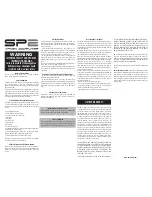
(1) Turn unit on.
(2) Set the mode switch to the “LCR” position.
(3) Set the Function/Range switch to the appropriate resistance
range. If the value of resistance is unknown, select the 2 ohm
range.
(4) Using a short piece of wire, such as a paper clip, temporarily
connect the po sitive and nega tive m easurement terminals
together. A lternatively, if t he clip leads w ill b e u sed for the
measurement, plug them into the banana jacks and connect
the clips together.
(5) Use a small, flat-blade screwdriver and slowly turn the “O Adj”
control to calibrate the display for a zero reading. Remove the
calibration short.
(7) Insert the resistor leads into the component test sockets at the
front of the meter. If the leads are too short, use the alligator
clip leads provided with the instrument to connect to resistor.
2.4
Measurement Parameter Conversions
The paramet er va lue for a co mponent mea sured in a parallel
equivalent circuit and that value me asured in a series equivalent
circuit may be diff erent fro m ea ch o ther. Th is means t hat the
parallel-measured capacitance (inductance) of any given capacitor
(inductor) will not be equal to the series-measured capacitance
(inductance) unless the dissipation factor of the capacitor (inductor)
equals zero. The equat ions in t he tab le be low sh ow the
relationship be tween the para llel- a nd the serie s- m easured
parameters of any given components:
Dissipation Factor Equations
(See table 1)
E.G.1:
With a m easurement fre quency of 1KH z, a para llel mo de
capacitance of 1000pF with a dissipation factor of 0.5 is equal to a
8
Summary of Contents for 875B
Page 12: ...10 ...
Page 19: ...MANUAL DE INSTRUCCIÓNES Medidor Digital LCR Modelo 875B ...
Page 28: ...26 ...











































